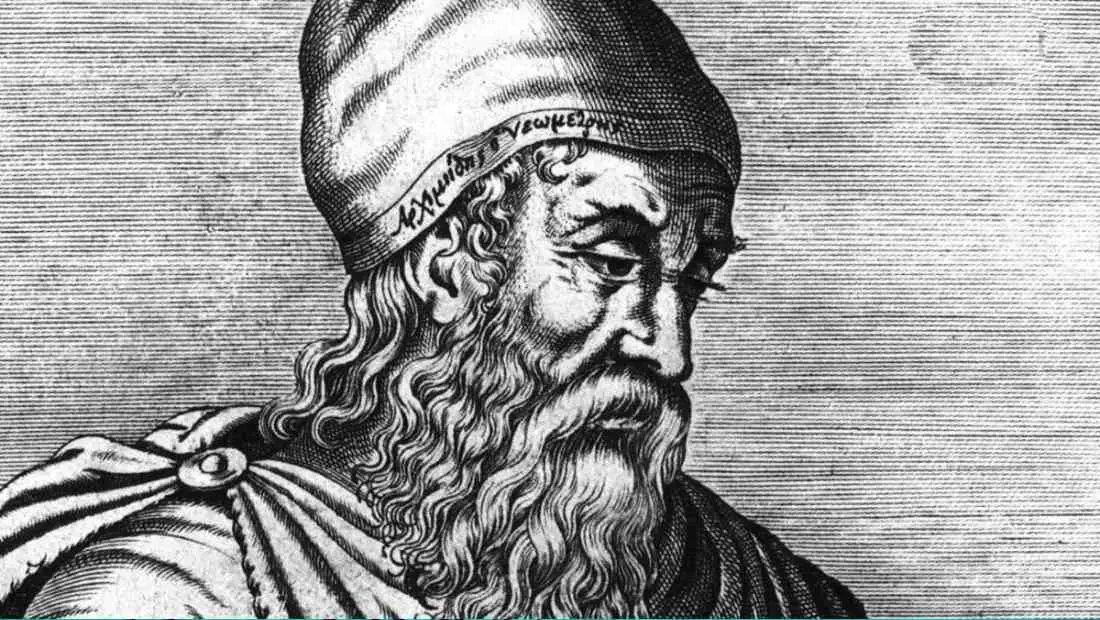Intro
Archimedes of Syracuse, Italy is the most famous mathematician, inventor, physicist, engineer and an astronomer in ancient Greece. Archimedes is a man who was both, of his time and far ahead of his time.
He was born in Greek city of Syracuse in approximately 287 BC. In the third century BC, Syracuse was a main hub of commerce, art and science.
As a youth in Syracuse, Archimedes inhabited his natural curiosity and penchant for problem solving.
When he had learned as much as he could from his mentors, Archimedes travelled to Egypt in order to study in Alexandria.
Founded by Alexander the Great in 331 BC, Alexandria at that time was famous for its great learning and scholarship, this very love for knowledge attracted Archimedes to Alexanderia.
Archimedes was the son of an astronomer and mathematician Phidias. Other than this fact little to nothing is known about the early life of Archimedes or his family. We only know this much because of the information provided in one of his works, The Sandreckoner.
According to historians it is also likely that when Archimedes was at a young age, he studied with the successors of Euclid in Alexandria. The primary versions of the life of Archimedes were written long after his death by Greek and by the Roman historians.
The earliest reference to Archimedes occurs in The Histories by the Polybius (c. 200 – 118 BC) which is written about seventy years after his death. Polybius sheds a little light on Archimedes as a person, and focuses on the war machines that he is said to have built which were in order to defend the city from the Romans at that time.
ARCHIMEDES INVENTIONS AND DISCOVERIES
Archimedes is especially KNOWN for his discovery and mathematically proving the relation between the surface and the volume of a sphere and its circumscribing cylinder.
Archimedes Principle
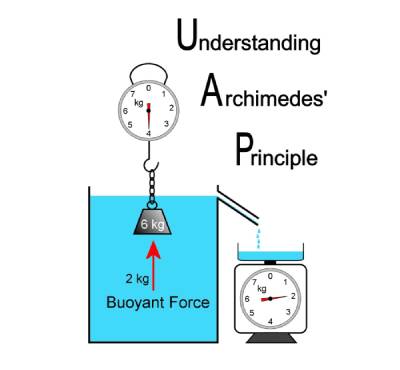
He is mostly famous for discovering the law of hydrostatics which is also known as ‘Archimedes Principle’. This law states that a body totally or partially immersed in a fluid is subject to an upward force that is equal in magnitude to the weight of fluid it displaces. The volume of the displaced fluid is equivalent to the volume of an object fully immersed in a fluid or to that fraction of the volume below the surface for an object partially submerged in a liquid.
This principle is used to keep heavy ships and objects afloat on water.
If the weight of the displaced water is less than the weight of the object itself, The object will sink.
If the weight of the displaced water is more than the weight of the object, the object stays afloat.
This explains the reason behind the bottom of ships and boats being wider than the top, they are designed this way to displace more water than its own weight.
Archimedes Screw
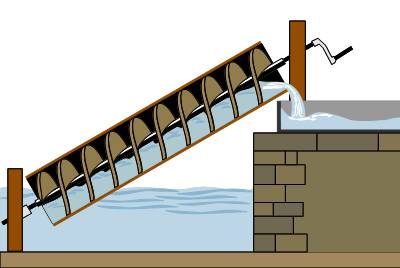
This remarkable yet simple invention is know by many names Egyptian screw, water screw, screw pump or the most popular one the Archimedes screw. This machine is used for raising water which is still used these days.
The water screw is rather like a screw placed within an empty tube, which can pull water up from a low lying river, lake, or well. This screw within the tube could be turned by various means like manual,cattle or wind.
As the screw is turned the lower end of the screw scoops up water and passes it upwards by the rotation of the helicoid screw and finally pours out of the top end of the tube.
In some cases The screw could be attached to the casing with pitch resin or other adhesive, or the screw and casing could be cast together as a single piece in bronze. This prevents water leakage through the helicoid screw, thus making it more efficient.
Although this invention is commonly attributed to Archimedes. But there are evidences that this device was being used in egypt long before archimedes in ancient Egypt.
Archimedes Death Ray
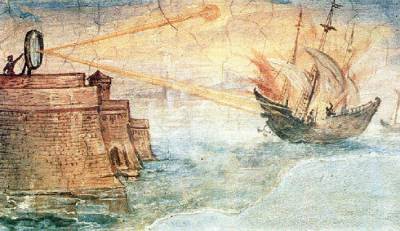
Archimedes have been behind the inventions of many extraordinary weapons like the claw of Archimedes and the catapult, but the most feared and debated weapon was the death ray.
Some scientist believe that it is a myth but others believe that there is a possibility that it could have existed as many experiments including one done by MIT group were able to produce some smoke and a small amount of flame. Although it could not set the wood on fire but indicates the possibility of its existence and application.
Archimedes’ heat ray was supposedly used in 212 BC when Rome had laid siege to Syracuse in the course of the Second Punic War. The death ray worked by focussing sun rays onto the roman ships by using polished mirrors held by the soldiers along the city walls.
Once the rays were collectively focused onto the ship, it created so much heat that the ship would burst into flames.
Claw of Archimedes
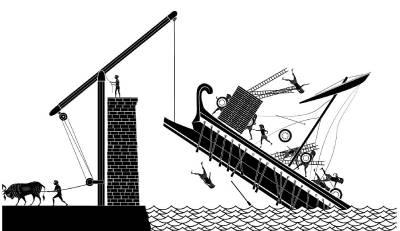
Also known as the iron hand, this ancient weapon was mounted on or behind city walls facing the sea. It worked as a crane with a grappling hook at its end, It could lift an attacking ship partly out of water and then drop it or turn it over depending on how the hook caught the ship.
This weapon was also used during the Second Punic War. Along with the death ray, these weapons had created so much fear in the hearts of romans, that, if they did but see a little rope or a piece of wood from the wall, instantly crying out, that there it was again Archimedes trying to fly some engine at them.
Compound Pulleys
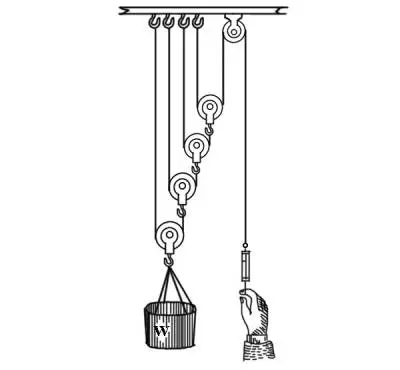
Archimedes invented the first compound pulleys. A compound pulley is a combination of fixed and movable pulley system. The system may contain more than two pulleys or ropes.
The more pulleys that are added the longer it will take to lift the object and on the other hand the object becomes that much easier to lift.
Plutarch a greek historian had mentioned that Archimedes had moved an entire ship filled with men using his own strength and a system of compound pulleys.
He once claimed, “Give me a place to stand and I will move the Earth” to King Hieron.
ARCHIMEDES ACHIEVEMENTS AND WORKS
The achievements of Archimedes are quite outstanding and he is considered by most historians of mathematics as one of the greatest mathematicians of all times. He perfected a method of integration which allowed him to find areas, volumes and surface areas of many bodies.
Archimedes was also able to apply the method of exhaustion, which is one of the early forms of integration, to obtain a whole range of important results. He also invented a system for expressing quite large numbers.
In mechanics, Archimedes discovered fundamental theorems concerning the centre of gravity of plane figures and also of the solids. His most famous work is by far the Archimedes principle.
The works of Archimedes which have survived are-
On plane equilibriums which are two book), Quadrature of the parabola, On the sphere and cylinder (two books have been released), On spirals, On conoids and spheroids, On floating bodies (two books), Measurement of a circle, and The Sandreckoner.
ARCHIMEDES’ LEGACY
Despite the many fantastic tales that surround the life of the great Archimedes, we are most indebted to him for his mathematical treatises and the contributions which he had made to the understanding of fundamental physical phenomena and also in the field of mathematics.
Through the medium of geometry, he was able to elucidate the principles for such basic devices he created like the compound pulley, the fulcrum and the lever and these are the devices which are still being utilized even today.
The story of the survival of Archimedes treatises down to our own time is very intricate and complicated, and it has been traced innovatively in extraordinary detailing.
But an essential point is that it is through three manuscripts that we know the texts of Archimedes treatises in Greek language. One was last heard of in 1311, a second was last heard of in the late 1550s, and the third is The Archimedes Palimpsest which is currently at The Walters Art Museum in Baltimore.
FACTS ABOUT ARCHIMEDES
- It is believed Archimedes was born around 287 BC in Syracuse in Sicily, but we do not know his exact birth date
- Archimedes was killed by a Roman soldier. It was when the Romans were conquering Syracuse.
- Archimedes didn’t only invent the simple machine called the lever, but he helped explain how the lever works, which is used by us till date.
- A biography on Archimedes was written by a friend of Archimedes who’s name was, Heracleides, but this was later lost. It is not known whether he was married or had children.
- A lot of the knowledge we have about Archimedes is anecdotal, which means that it is probably based in truth but has been added to with lots of details over thousands of years.
- For instance, the story that when Archimedes had made an exciting discovery (Archimedes principal) while soaking in his bathtub he ran through the streets naked shouting “Eureka!” which means that “I have found it!” in Greek language which is probably not true!
- In order to honor the great Archimedes, a crater of the moon has been named after him.
- Archimedes was far before his time in mathematics, it took us an extra 1800 years before his work was fully understood by Sir Newton.
- Archimedes is credited with inventing the Archimedes screw which is an easy machine for moving water that’s still used till date.
- Archimedes was the reason behind the understanding of the formula of density.
- It is said that Archimedes used to enjoy teasing other mathematicians, giving them the answer to a complex question but not helping them to understand how he had worked it out.
HOW DID ARCHIMEDES DIE?
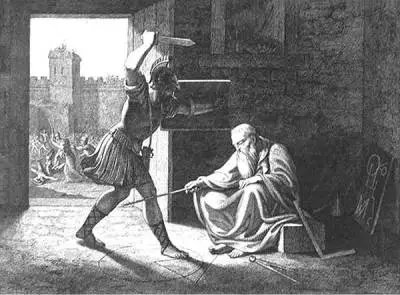
Archimedes died during the seige of Syracuse in 212 BC during the Second Punic War. Before laying siege to Syracuse the roman army lead by Marcus Claudius Marcellus was ordered to capture Archimedes alive.
According to the popular account given by the Greek biographer Plutarch, Archimedes was busy drawing circles when a roman soldier entered his room and commanded him to meet General Marcellus.
He was so occupied with his work that he failed to recognize the roman soldier and shouted “Do not disturb my circles” The soldier was enraged by this, and killed Archimedes with his sword.
After his death he was buried in a tomb on which was carved a sphere, within a cylinder. This was his wish, because he believed his greatest achievement was finding the formula for the quantity of a sphere.
Much of his work has also been lost forever, but what we all know of it leaves us in awe of his achievements.
More than 300 years after Archimedes’ death the Greek historian Plutarch said of him:
“Archimedes possessed so high a spirit, so profound a soul, and such treasures of scientific knowledge, that though these inventions had now obtained him the renown of more than human sagacity, he yet would not deign to leave behind him any commentary or writing on such subjects; but, repudiating as sordid and ignoble the whole trade of engineering, and every sort of art that lends itself to mere use and profit; he placed his whole affection and ambition in those purer speculations where there can be no reference to the vulgar needs of life..”
On his tomb, additionally to the sphere within the cylinder, his name was written in Greek: ΑΡΧΙΜΗΔΗΣ
REFERENCES
www.bbc.com
www.wikipedia.in
www.famousscientists.org
www.mathshistory.st-abdrews.ac.uk
www.exploratorium.edu
www.britannica.com
www.ducksters.com
www.archimedespalampest.org
www.theschoolrun.com
www.vigyanprasar.gov.in

